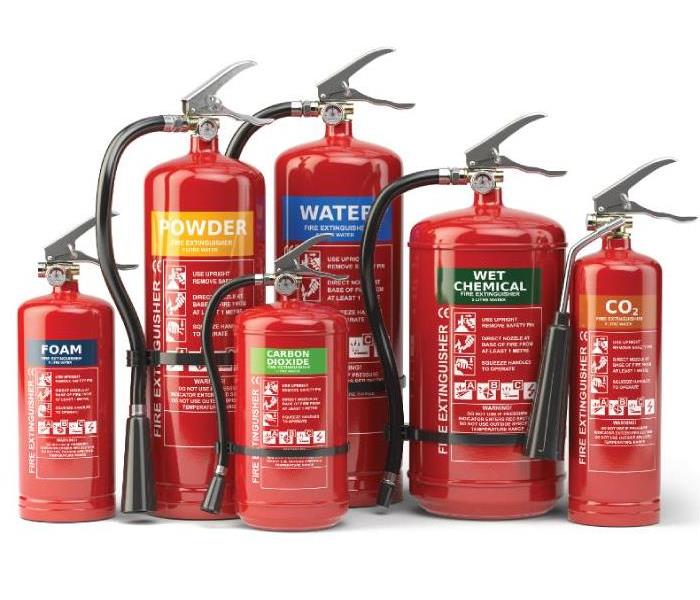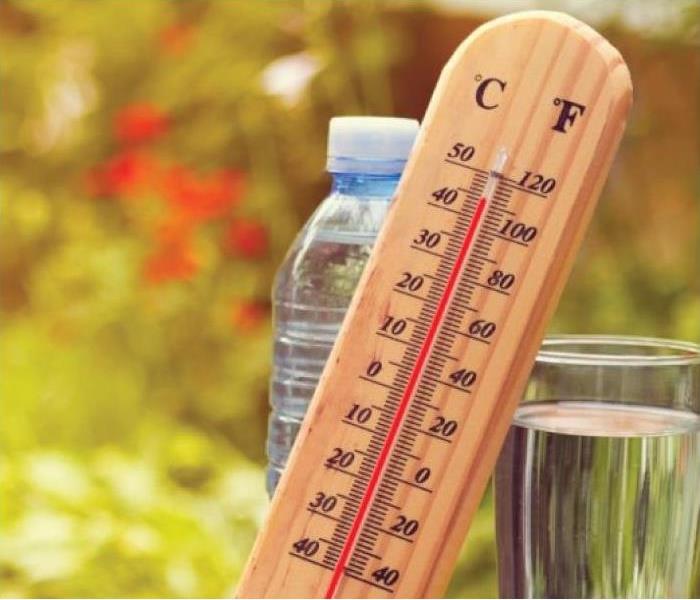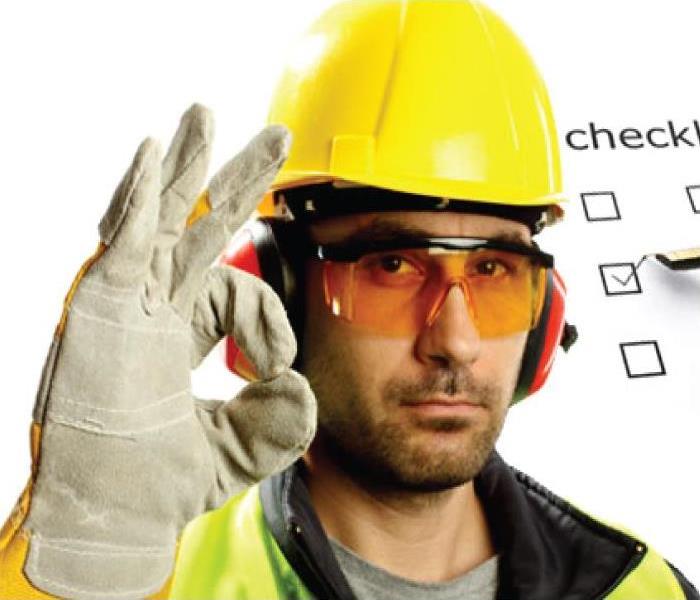Recent General Posts
The Importance of Personal Protective Equipment
7/1/2019 (Permalink)
Safety is a major issue for day laborers and skilled laborers. Each year, accidents happen frequently in the construction industry and often times it is due to the absence of Personal Protective Equipment (PPE) or failure to wear the provided PPE. PPE is equipment that will protect workers against health or safety risks on the job. The purpose is to reduce employee exposure to hazards when engineering and administrative controls are not feasible or effective to reduce these risks to acceptable levels. These hazard risks can be anything from wet floors to falling debris and everything in between. PPE includes items such as protective helmets, eye protection, high-visibility clothing, safety footwear, safety harnesses and, sometimes, respiratory protective equipment. Let’s explore some PPE commonly used on construction sites and their benefits:
- Head Protection
Hard hats are common on construction sites. Just passing by a site, you can usually identify workers by their hard hats. They are designed to protect against flying or falling objects that would otherwise impact or penetrate the worker. Some hard hats are equipped with accessories such as face shields and earmuffs. Hard hats should be well-fitted; those that are too large or too small are inappropriate for use.
- Eye and Face Protection
Eye and face protection are equally as important as head protection. Safety goggles, spectacles and full face shields can give you the protection needed for the eyes and face. Metal work, wood-work, hot-work and air-tool operations all require this type of protection. General laborers can also benefit from safety goggles since there is usually debris on construction sites.
- Respiratory protection
Respiratory protection is vital on sites where toxic substances are present. Sometimes what you can’t see can hurt you. Respiratory protections like respirators are designed to protect you from dust, fumes, paint spray, pesticides and other dangerous substances that could cause permanent impairment. Respiratory protection should be used in environments with air contaminants. In work environments, respirators are relied upon when adequate ventilation is unavailable or other engineering control systems are not feasible or inadequate.
- Hand & Skin protection
Construction jobs typically require the use of hands. Each year, around 150,000 hand injuries are reported. Occupational skin diseases such as contact dermatitis, skin cancers, and other skin injuries and infections are the second most common type of occupational disease and can be very costly. Because a lot of work is done with the hands, gloves are an essential item in providing skin protection. Some examples of gloves commonly used as PPE include rubber gloves, cut-resistant gloves, chainsaw gloves and heat-resistant gloves. Using gloves helps to avoid hazards usually involved when working with chemicals, glass, sheet metal, electricity, hot materials or slippery objects.
- Hearing protection
Industrial noise is often discounted as an occupational hazard since it isn’t visible to the eye. However, 22 million workers in the United States are exposed to potentially harmful noise levels annually. According to the National Institute for Occupational Safety and Health, about 82% of occupational hearing loss cases occurred to workers in the manufacturing sector. The Occupational Safety and Health Administration establishes occupational noise exposure standards. NIOSH recommends that worker exposures to noise be reduced to a level equivalent to 85 dBA for eight hours to reduce occupational noise-induced hearing loss. Earplugs and earmuffs are common hearing protection tools. It is important to note that earmuffs are more effective in reducing high-frequency noise while earplugs are more effective for reducing low-frequency noise.
How to Properly Use a Fire Extinguisher
4/29/2019 (Permalink)
 Do you know how to properly use a fire extinguisher?
Do you know how to properly use a fire extinguisher?
Fire extinguishers. You pass them all the time as you walk the hallways at work or school, and hopefully at home too.
But no matter how many times you’ve seen them in your day-to-day life, you’ve probably given little thought as to how you actually use one. Maybe it never crossed your mind, or maybe you assume it’s so simple it’s not something you need to learn.
Well, it’s true that using a fire extinguisher isn’t rocket science by any stretch, but there are a few basics you need to be aware of – and probably aren’t. According to FEMA, the majority of Americans don’t know how to use an extinguisher, even if they have one in their home. This is a dangerous knowledge gap. Fires double in size every 60 seconds, so you don’t want to be fumbling around in an emergency situation, reading over the instruction manual as a small flame on the stove grows into an inferno.
Most fire extinguishers operate using the following P.A.S.S. technique:
- PULL... Pull the pin. This will also break the tamper seal.
- AIM... Aim low, pointing the extinguisher nozzle (or its horn or hose) at the base of the fire.
NOTE: Do not touch the plastic discharge horn on CO2 extinguishers, it gets very cold and may damage skin.
- SQUEEZE... Squeeze the handle to release the extinguishing agent.
- SWEEP... Sweep from side to side at the base of the fire until it appears to be out. Watch the area. If the fire re-ignites, repeat steps 2 - 4.
If you have the slightest doubt about your ability to fight a fire....EVACUATE IMMEDIATELY!
Getting Your HVAC/Air Conditioner Ready for Summer
4/1/2019 (Permalink)
 Getting Your HVAC/Air Conditioner Ready for Summer
Getting Your HVAC/Air Conditioner Ready for Summer
It is such a great feeling when you can finally turn off the heater. However, you will need to turn on the air conditioner a few weeks later. Are you concerned about the massive summer energy bills that will be dropped in your mailbox? If energy costs are on your mind, you can start preparing your HVAC system for the summer. When you prepare your air conditioning unit for the summer months, you can prevent expensive HVAC malfunctions. Air conditioning units are usually the cause of poor indoor air quality. When your air conditioner is serviced, the system will not have an environment that is suitable for mold growth. A clean air conditioning unit may eliminate some offensive odors.
Inspect the Air Conditioner Filters
We can inspect and replace the filters. The filters are an important part of your air conditioning unit. They filter debris and regulate the air temperature. If the filters are dirty, pollen, debris, and dust will circulate throughout the room. A clogged filter will also cause the filter to work less efficiently. The energy bills will be higher when the air conditioning unit has to work harder. Clean filters will block dust, airborne pathogens, pollen and other particles that affect indoor air quality.
Inspect the Air Duct
Our technicians can look for obstructions in the ductwork. We will look for debris, and we will inspect the joints. Air duct cleaning is not always a necessity. We will recommend the best way to resolve indoor air quality problems. Our recommendations will save you money and give you peace of mind.
Remove Debris from the Exterior Unit
We can also remove debris from the exterior unit. There should be at least two feet of clear space. The air cannot flow freely if bushes are blocking the unit.
Examine the Condensation Removal System
Warm air can cause a condensation buildup in the cooling coil. We can test the switches, and we can use several condensation removal techniques.
At SERVPRO of East Fullerton / Placentia, we can help homeowners and business owners prepare their HVAC system for the summer months. We can perform detailed maintenance checks.
Statistics Highlight the Need for Preparation and Caution in Holiday Decorating and Entertaining
12/10/2013 (Permalink)
Statistics Highlight the Need for Preparation and Caution in Holiday Decorating and Entertaining
Local SERVPRO® restoration specialist offers tips for preventing holiday fires
Fullerton, CA (Grassroots Newswire) November 18, 2013 -- Lights, candles, action – it’s the holiday season again. Brightly lighted decorations, elaborate meals and large gatherings are all part of traditional holiday celebrations. Unfortunately, these seasonal traditions also cause an average of 230 home fires each year, with an average of 4 deaths, 21 injuries and $17.3 million in property damage.
“Christmas tree lights and candles are just two of the holiday traditions that increase the likelihood of a fire starting in your home,” says Robert Skelton of SERVPRO® of East Fullerton/Placentia. “There are about three times as many cooking-related fires on Thanksgiving Day and almost twice as many on Christmas Day as there are on non-holidays. It only takes a single distracted or careless action to turn a family get-together into a tragedy.”
Skelton says that homeowners can help keep their homes and their families safe during the holiday season by understanding the dangers and taking some simple, commonsense precautions.
Holiday Cooking Fire Facts
· Thanksgiving Day has three times the average number of reported home structure fires involving cooking equipment.
· The two other peak days for cooking-related fires are Christmas Day and Christmas Eve.
Holiday Cooking Safety Tips
· Supervise items on the stovetop. Fifty-eight percent of kitchen fires involve ranges; homes with electric cooktops have a higher risk of fire than homes with gas cooktops.
· Keep flammable items – potholders, packaging, wrapping, wooden utensils, loose clothing – away from the stovetop.
· Don’t let lack of sleep or alcohol consumption affect your ability to concentrate on preparing the meal.
Holiday Decorating Fire Facts
· Half of all holiday decoration fires start because the decoration is too close to a heat source.
· On average, 32 candle fires are reported each day. December is the peak month for candle fires.
Holiday Decorating Safety Tips:
· Keep all decorations away from heat sources like radiators, portable heaters, and fireplaces.
· Use flameless candles.
· If you do use traditional candles, burn them in sturdy candleholders, well away from drapes and other flammable materials. Never leave them unattended and never allow them to burn down to less than one inch in length.
Christmas Tree Fire Facts:
· 50% of live tree fires occur between December 22 and January 5.
· 31% of tree fires are caused by electrical problems.
· 14% involve decorative lights.
Christmas Tree Safety Tips:
· Keep live trees well watered to reduce the chance of a fire.
· Check wiring on lights for breaks and wear, replace worn strings and don’t exceed manufacturer guidelines for connecting multiple strands of lights.
· Don’t leave tree lights plugged in when you are away from home or asleep.
“We hope these tips will be a reminder to Fullerton area families to make fire prevention a priority in their holiday preparations,” said Skelton, “so they can spend the season enjoying family and friends, not dealing with the aftermath of a fire.”
For more fire prevention tips and information about fire and water damage restoration services, contact Robert Skelton with SERVPRO® of East Fullerton/Placentia at 1-877-460-9414 or r_skelton@verizon.net.
National Preparedness Month
8/31/2013 (Permalink)
SERVPRO Fullerton/Placentia cares about the seniors in our area. That is why we are making a concerted effort to reach out to seniors in order to help them prepare in case of a disaster. We will be visiting Senior Living complexes and churches in our area. Providing valuable information.
The likelihood that you and your family will recover from an emergency tomorrow often depends on the planning and preparation done today. While each person's abilities and needs are unique, every individual can take steps to prepare for all kinds of emergencies. By evaluating your own personal needs and making an emergency plan that fits those needs, you and your loved ones can be better prepared.
Those are commonsense measures older Americans can take to start preparing for emergencies before they happen.
The link to the video below will help you be prepared:
http://www.fema.gov/medialibrary/media_records/7050
For more information please see www.redcross.org
Preparing Makes Sense for Older Americans www.fema.gov.






 24/7 Emergency Service
24/7 Emergency Service


